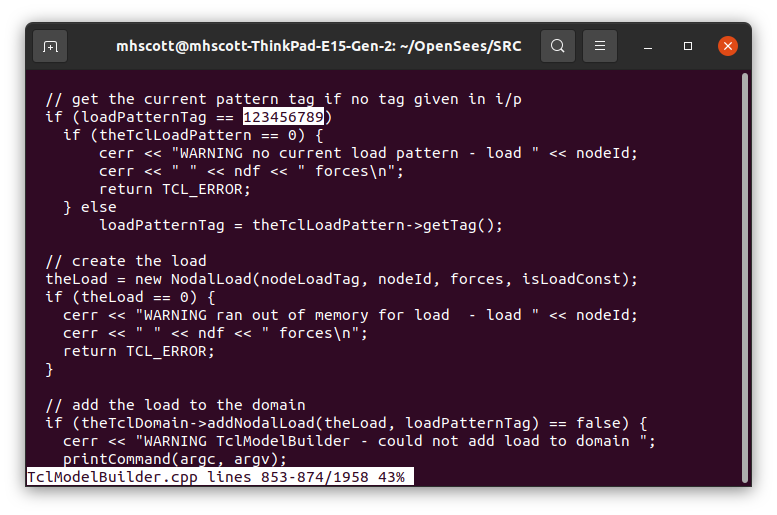OpenSees Cloud
OpenSees AMI
OpenSees 12345
Original Post - 26 Jun 2022 - Michael H. Scott
Show your support at Buy Me a Coffee.
In the early 2000s, when the Tcl interpreter was taking shape for
OpenSees, Frank used a dummy tag 123456789 to determine if a load
pattern had already been defined while parsing the load and sp commands.
Here is the
2001 source code
for TclModelBuilder.cpp–clearly written by
Frank because he does not capitalize anything when he comments.

I gave Frank a hard time about this dubious software engineering decision: “What if someone legitimately defined a load pattern with tag 123456789? It’ll totally break your parsing logic”. Frank relented and modified the code to use more reliable true/false logic.
Today, I did some recursive grepping for other occurrences of sequential numbers like 12345 or 54321. Discounting a class tag, which is truly harmless, the only thing that came up was some questionable logic in MPCORecorder.cpp and RemoveRecorder.cpp. I’ll spare you the screenshots, but the links will take you to the offending lines on GitHub. In summary though:
- Don’t use the MPCO recorder if your model has a section with tag -123456.
- Don’t remove elements from your model if you have issued more than 987654 nodal load commands or if you remove an element with tag -32922 that also has more than six nodes, regardless of the number of nodal loads.
I know these rules sound crazy, but I’m just interpreting the code.
There could be other magic numbers embedded in OpenSees, e.g., a YYYYMMDD birth date of whoever wrote Concrete23, or their first born. But there’s no easy way to find those occurrences.
I admit though, on the C++ side of OpenSees, it is a little difficult to get unique tags out of the domain and model builder. So I can see the appeal of using a number “that no one will ever use”. But, eventually, someone will use it.
However, if you’re writing a Python or Tcl script for OpenSees, there’s no excuse for using magic numbers like 12345 in your script.
You need a burner node tag? Use getNodeTags, then add one to the maximum
value. You need a throw away element tag? Use getEleTags and add one.
You need a parameter tag for a hot minute? Well, you know what to do
with getParamTags.
Here’s what you would do in OpenSeesPy.
uniqueNodeTag = max(ops.getNodeTags()) + 1
uniqueEleTag = max(ops.getEleTags()) + 1
uniqueParamTag = max(ops.getParamTags()) + 1
The syntax for a one liner in OpenSees Tcl is even messier than I expected.
set uniqueNodeTag [expr [tcl::mathfunc::max {*}[getNodeTags]] + 1]
set uniqueEleTag [expr [tcl::mathfunc::max {*}[getEleTags]] + 1]
set uniqueParamTag [expr [tcl::mathfunc::max {*}[getParamTags]] + 1]
Abracadabra, no more magic numbers in your scripts!
The magic numbers remind me of the scene from Spaceballs where Dark Helmet gets the combination to unlock Planet Druidia’s atmosphere.
